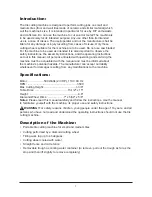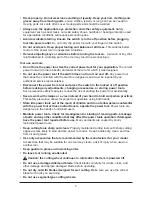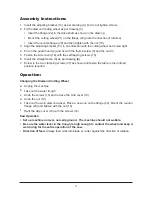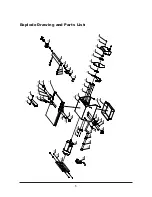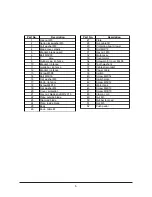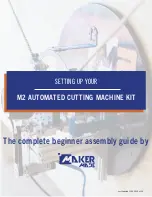
• Dress properly. Do not wear loose clothing of jewelry. Keep your hair, clothing and
gloves away from moving parts.
Loose clothes, jewelry or long hair can be caught in
moving parts. Air vents often cover moving parts and should be avoided.
• Always use the appropriate eye protection and other safety equipment.
Safety
equipment such as dust mask, non-skid safety shoes, hardhat, or hearing protection used
for appropriate conditions will reduce personal injuries.
• Avoid accidental starting. Ensure the switch is in the off position before plugging
tool into power outlet.
Do not carry the power tool with your finger on the switch.
• Do not overreach. Keep proper footing and balance at all times.
This enables better
control of the power tool in unexpected situations.
• Remove adjusting keys or wrenches before turning the tool on.
A wrench or key that
is left attached to a rotating part of the tool may result in personal injury.
Tool use and care
• Do not force the power tool. Use the correct power tool for your application.
The correct
power tool will do the job better and safer at the rate for which it was designed.
• Do not use the power tool if the switch does not turn it on and off.
Any power tool
that cannot be controlled with the switch is dangerous and must be repaired by an
authorized service representative.
• Disconnect the power from tool and place the switch in the locked or off position
before making any adjustments, changing accessories, or storing power tools.
Such preventive safety measures reduce the risk of starting the power tool accidentally.
• Secure work with clamps or a vise instead of your hand to hold work when practical.
This safety precaution allows for proper tool operation using both hands.
• Store idle power tools out of the reach of children and do not allow persons unfamiliar
with the power tool or these instructions to operate the power tool.
Power tools are
dangerous in the hands of untrained users.
• Maintain power tools. Check for misalignment or binding of moving parts, breakage
of parts and any other condition that may affect the power tools operation. If damaged,
have the power tool repaired before use.
Many accidents are caused by poorly
maintained power tools.
• Keep cutting tools sharp and clean.
Properly maintained cutting tools with sharp cutting
edges are less likely to bind and are easier to control. Keep handles dry, clean, and free
from oil and grease.
• Use only accessories that are recommended by the manufacturer for your model.
Accessories that may be suitable for one tool may create a risk of injury when used on
another tool.
• Keep guards in place and in working order.
• Do leave tool running unattended.
Caution: the cutting wheel continues to rotate after the item is powered off.
• Do not use a damaged diamond blade.
Check blades carefully for cracks, nicks, and
other damage and replace damaged blade before operating.
• Do not dry cut with blades designed for wet cutting.
Make sure you use the correct
blasé for the job you are doing.
• Do not use segment-type cutting wheels.
3
Содержание 1555811
Страница 8: ......


